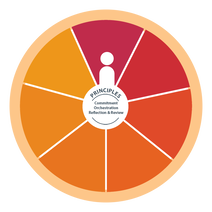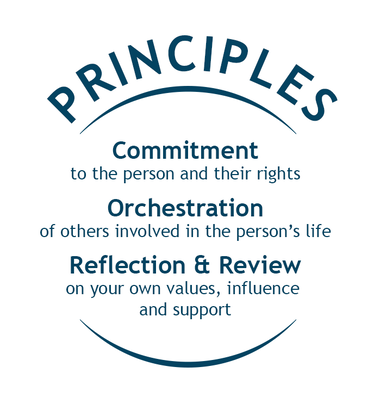|
There are 3 Principles that you will use at each Step of the decision making process.
These are:
The Principles are shown in Figure 7.
|
This video talk is an introduction to the Principles:
Commitment
This principle requires supporters to demonstrate a consistent commitment to:
- The person
- The person's rights to be actively involved in their decision making. All decisions must reflect the person’s preferences, will and rights.
Supporters may find that their commitment may be challenged as they work through the Steps to support decision making.
Challenges can arise, for example, when supporters impose their own views onto the person if they disagree with preferences or others try to ignore the person’s rights to participate in decision making.
The relationship between the supporter and the person does not have to be ‘perfect’ but it does need to be built on unconditional positive regard for the person as a human being of equal value and a holder of rights.
Supporters will need to use a range of strategies, tools, values and knowledge so that the person’s preferences can be achieved in spite of the challenges being presented to them.
This video shows an example of commitment.
Watch the video and then answer the questions. Write in the downloadable workbook located in the Resources section.
- In what ways does Sarah’s mum demonstrate her commitment to Sarah’s relationship with Ron?
- What are some of the benefits to the person when supporters maintain positive expectations throughout the decision making process?
- Think of a person you support. What are some ways you demonstrate your commitment to them during the decision making process?
Orchestration
Decision making is a shared task.
People involved in the decision making process include:
- the person
- the primary or lead supporter
- other supporters, including advocates
The support is shared between a range of people who know the person in different ways. These people can include support workers, managerial staff, friends and family members.
A primary supporter leads and orchestrates support.
Like the conductor of a musical orchestra, the primary supporter draws in other supporters, both formal and informal, from various parts of the person’s life. They update other supporters with information as required and also mediate any differences between supporters.
The primary supporter will orchestrate people with appropriate skills, and if necessary those with expert knowledge, at a particular time and for a particular duration in order to act on a decision.
If a primary supporter is not evident, then for some decisions, it will be necessary to find someone willing to take on that role.
This video shows an example of orchestration.
Watch the video and then answer the questions. Write in the downloadable workbook located in the Resources section.
- Sarah’s mum makes a number of suggestions to Tess about how she can help in Sarah’s decision. What are these?
- How does Sarah’s mum respond to Tess’ concern about Sarah making the ‘wrong’ decision?
- What is the one thing that Tess is asked to do now to support Sarah’s decision?
- As a supporter, and with the knowledge you have gained from this resource so far, do you think there are ‘wrong’ decisions? Explain.
Reflection & Review
As a supporter, you need to continually reflect on and review the support you provide for decision making all through the process.
Supporters must reflect to ensure that they are not influencing a decision based on their own values or preferences in the way they present information.
In their study, Bigby, Whiteside & Douglas (2017) recorded the following information provided by one mother who sought to delay a decision. She advised that if her daughter wanted to leave home she had to:
learn to be independent in cooking and budgeting, paying … bills, learn how not to use too much electricity or gas…(p. 7). |
This statement from another family member in the study highlights how supporters can deliberately present information that is framed by their own perspective:
we did provide [the information] in such a way that we knew what decision [the person] would make. |
Asking yourself the following questions may help you to reflect and review:
- Are my core values getting in the way of the person’s decision?
- Am I being biased in the way I have presented the options or framed the information?
- Are my opinions changing the decision the person wants?
- Am I being judgemental?
- Have I put aside my own preferences?
- At all times, have I focussed on the preferences of the person I am supporting?
- Have I enabled the person to take risks or have you taken a protective stance? Further information about risk enablement can be found here: http://www.enablingriskresource.com.au/
As a supporter, you must take time to reflect to become aware of your influence. Your actions can enable or obstruct a decision.
Continual reflection and review is vital to ensure that your views are not getting in the way of effective support for decision making. Talking your experiences or a specific example through with someone might assist you to reflect and review.
This video shows an example of reflection and review.
Watch the video and then answer the questions. Write in the downloadable workbook located in the Resources section.
- Jen is Carol’s mum. She raises some worries about Carol with her friend, Mary. What are Jen’s concerns?
- Do you think that Jen has put aside her own preferences in supporting Carol?
- Explain how Mary helps Jen reflect and review.
Summary Module 4
The Principles are associated with every Step in the support for decision making process.
This Module has highlighted that supporters must:
- Be committed to the person’s rights to be actively involved in decision making
- Coordinate other supporters and involve them when required to implement the decision or parts of it
- Remain non-judgemental.




